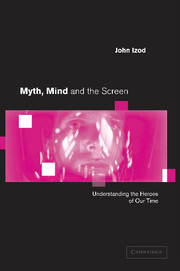Book contents
- Frontmatter
- Contents
- Acknowledgments
- Introduction
- 1 Jungian theory, textual analysis and audience play
- 2 Archetypal images: signification and the psyche
- 3 Archetypal images: symbols and the cultural unconscious
- 4 The Piano, the animus and colonial experience
- 5 The pop star as icon
- 6 The quest of a female hero: The Silence of the Lambs
- 7 Television sport and the sacrificial hero
- 8 The polycentred self: The Passion of Darkly Noon
- 9 Haunted: searching for the whole self
- 10 Transforming the final ghost: the god within
- Conclusion
- Filmography
- Glossary of Jungian and related terms
- References
- Index
8 - The polycentred self: The Passion of Darkly Noon
Published online by Cambridge University Press: 22 September 2009
- Frontmatter
- Contents
- Acknowledgments
- Introduction
- 1 Jungian theory, textual analysis and audience play
- 2 Archetypal images: signification and the psyche
- 3 Archetypal images: symbols and the cultural unconscious
- 4 The Piano, the animus and colonial experience
- 5 The pop star as icon
- 6 The quest of a female hero: The Silence of the Lambs
- 7 Television sport and the sacrificial hero
- 8 The polycentred self: The Passion of Darkly Noon
- 9 Haunted: searching for the whole self
- 10 Transforming the final ghost: the god within
- Conclusion
- Filmography
- Glossary of Jungian and related terms
- References
- Index
Summary
This chapter derived much of its shape and several of its core ideas from work done by my former research student Catriona Miller, for whose generous input I am most grateful.
This and the following two chapters examine films that present the spectator with images of the archetype of wholeness, the self. The followers of Jung, in the course of their ruminations about the nature and functioning of the psyche, developed two distinct models of the self. Although they are not irreconcilable, they do have a different basis. The older model, originally delineated by Jung himself, is the Classical configuration. It characterises psychological development as progress towards an individuation in which unity is achieved through the balancing out of opposites. The many are contained within the one: the entire pantheon of archetypal energies is held in balance within the one overarching dominant, the self. It goes with this that the Classical model often features the self though a single godhead, and is for that reason described as monotheistic. Given the dominance in Western cultures of belief in the individual as a unique personality, it is not surprising that our screen fictions often feature monotheistic models of the self. We shall analyse examples of such fictions in the two chapters that follow this.
The Classical model has limitations which inhibit good therapeutic practice, in the opinion of some Jungian psychoanalysts.
- Type
- Chapter
- Information
- Myth, Mind and the ScreenUnderstanding the Heroes of our Time, pp. 143 - 159Publisher: Cambridge University PressPrint publication year: 2001



